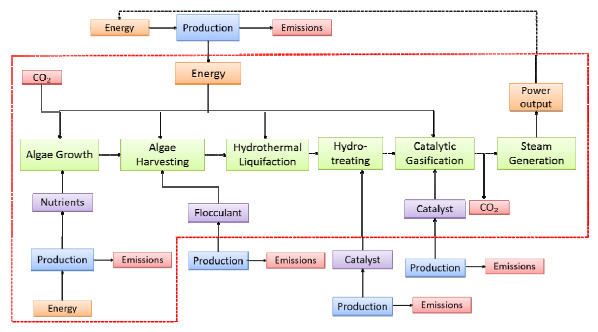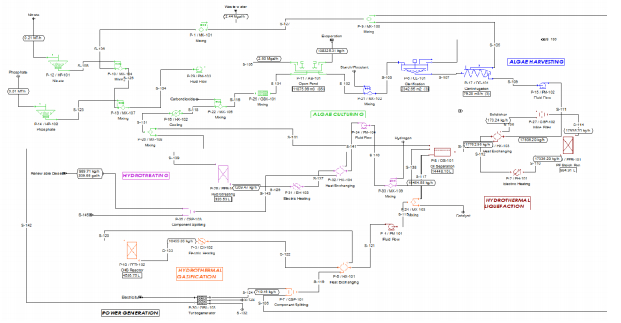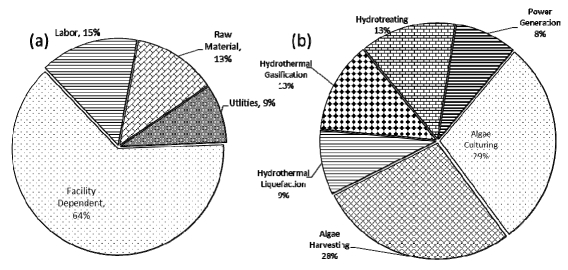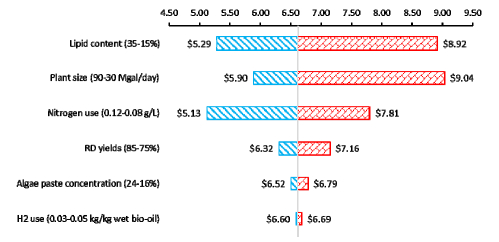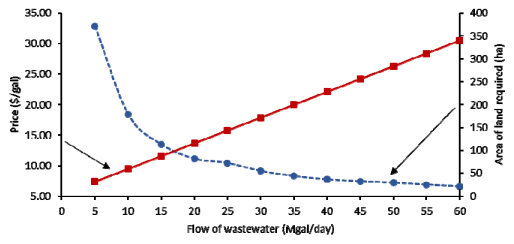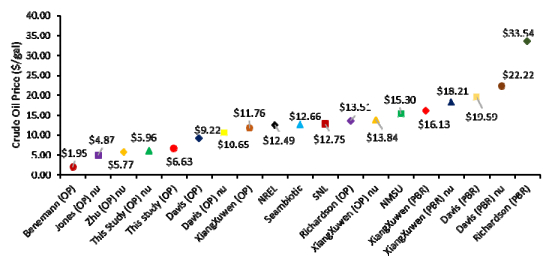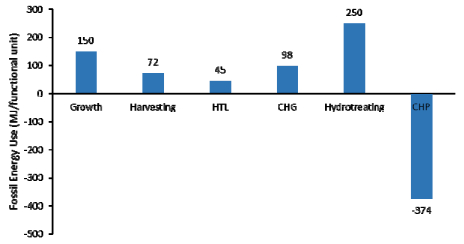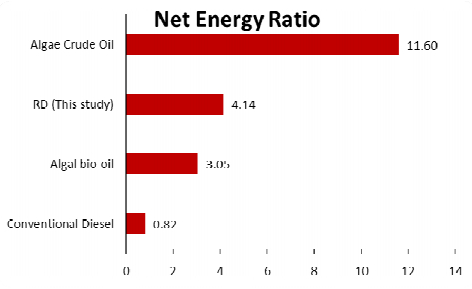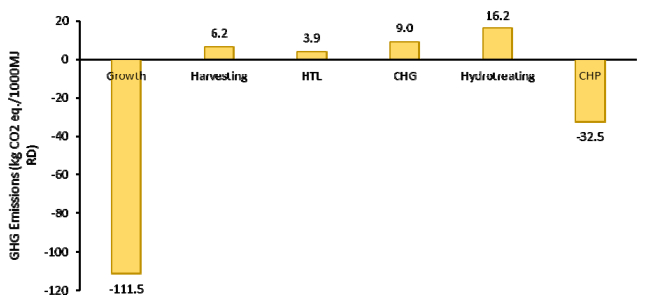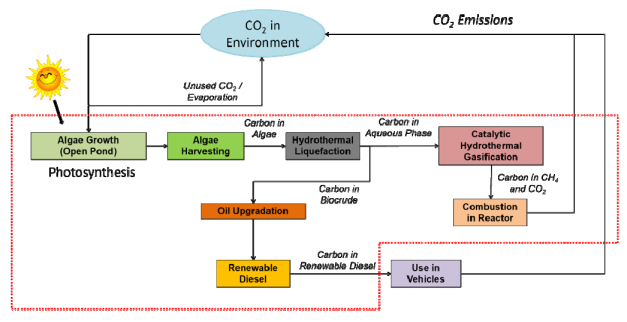| 1.
|
Ankita Juneja, Ganti S. Murthy,
Model predictive control coupled with economic and environmental constraints for optimum algal production,
2018,
250,
09608524,
556,
10.1016/j.biortech.2017.11.047
|
|
| 2.
|
Xiangyu Gu, Liang Yu, Na Pang, Jose Salomon Martinez-Fernandez, Xiao Fu, Shulin Chen,
Comparative techno-economic analysis of algal biofuel production via hydrothermal liquefaction: One stage versus two stages,
2020,
259,
03062619,
114115,
10.1016/j.apenergy.2019.114115
|
|
| 3.
|
L. Soto-Sierra, S. Kulkarni, S. L. Woodard, Z. L. Nikolov,
Processing of permeabilized Chlorella vulgaris biomass into lutein and protein-rich products,
2020,
32,
0921-8971,
1697,
10.1007/s10811-020-02055-x
|
|
| 4.
|
Tamás Mizik, Gábor Gyarmati,
Economic and Sustainability of Biodiesel Production—A Systematic Literature Review,
2021,
3,
2571-8797,
19,
10.3390/cleantechnol3010002
|
|
| 5.
|
Bunushree Behera, Nazimdhine Aly, P. Balasubramanian,
Biophysical model and techno-economic assessment of carbon sequestration by microalgal ponds in Indian coal based power plants,
2019,
221,
09596526,
587,
10.1016/j.jclepro.2019.02.263
|
|
| 6.
|
Gulab Singh, S. K. Patidar,
Development and Applications of Attached Growth System for Microalgae Biomass Production,
2020,
1939-1234,
10.1007/s12155-020-10195-8
|
|
| 7.
|
Verónica Campos-Guzmán, M. Socorro García-Cáscales, Nieves Espinosa, Antonio Urbina,
Life Cycle Analysis with Multi-Criteria Decision Making: A review of approaches for the sustainability evaluation of renewable energy technologies,
2019,
104,
13640321,
343,
10.1016/j.rser.2019.01.031
|
|
| 8.
|
Amir Akbari, Paul I. Barton,
Integrating Genome-Scale and Superstructure Optimization Models in Techno-Economic Studies of Biorefineries,
2019,
7,
2227-9717,
286,
10.3390/pr7050286
|
|
| 9.
|
Richard Gordon, Richard Gordon, Clifford R Merz, Shawn Gurke, Benoît Schoefs,
2019,
9781119370215,
583,
10.1002/9781119370741.ch22
|
|
| 10.
|
Enrique Medina Martos, Ioan-Robert Istrate, Javier Dufour,
2020,
9780128162040,
435,
10.1016/B978-0-12-816204-0.00019-9
|
|
| 11.
|
Mayank Kumar, Adetoyese Olajire Oyedun, Amit Kumar,
A Comparative Technoeconomic Analysis of Algal Thermochemical Conversion Technologies for Diluent Production,
2020,
8,
2194-4288,
1900828,
10.1002/ente.201900828
|
|
| 12.
|
Arun K. Vuppaladadiyam, Pepijn Prinsen, Abdul Raheem, Rafael Luque, Ming Zhao,
Sustainability Analysis of Microalgae Production Systems: A Review on Resource with Unexploited High-Value Reserves,
2018,
52,
0013-936X,
14031,
10.1021/acs.est.8b02876
|
|
| 13.
|
Devinder Singh, Giovanna Gonzales-Calienes,
2021,
Chapter 11,
978-981-15-7517-4,
243,
10.1007/978-981-15-7518-1_11
|
|
| 14.
|
Na Wu, Cesar M. Moreira, Yingxiu Zhang, Nguyet Doan, Shunchang Yang, Edward J. Phlips, Spyros A. Svoronos, Pratap C. Pullammanappallil,
2019,
Chapter 6,
978-1-83881-849-4,
10.5772/intechopen.86090
|
|
| 15.
|
Didem Özçimen, Benan İnan, Anıl Tevfik Koçer, Meyrem Vehapi,
2018,
Chapter 10,
978-1-78923-332-2,
10.5772/intechopen.73702
|
|
| 16.
|
Panneerselvam Ranganathan, Sivaraman Savithri,
Techno-economic analysis of microalgae-based liquid fuels production from wastewater via hydrothermal liquefaction and hydroprocessing,
2019,
284,
09608524,
256,
10.1016/j.biortech.2019.03.087
|
|
| 17.
|
Mayank Kumar, Adetoyese Olajire Oyedun, Amit Kumar,
2019,
9780128168561,
715,
10.1016/B978-0-12-816856-1.00029-4
|
|
| 18.
|
Jamison Watson, Tengfei Wang, Buchun Si, Wan-Ting Chen, Aersi Aierzhati, Yuanhui Zhang,
Valorization of hydrothermal liquefaction aqueous phase: pathways towards commercial viability,
2020,
77,
03601285,
100819,
10.1016/j.pecs.2019.100819
|
|
| 19.
|
Shiv Prasad, Dheeraj Rathore, Anoop Singh,
2021,
Chapter 11,
978-981-15-9695-7,
249,
10.1007/978-981-15-9696-4_11
|
|
| 20.
|
Esveidi Montserrat Valdovinos-García, Juan Barajas-Fernández, María de los Ángeles Olán-Acosta, Moisés Abraham Petriz-Prieto, Adriana Guzmán-López, Micael Gerardo Bravo-Sánchez,
Techno-Economic Study of CO2 Capture of a Thermoelectric Plant Using Microalgae (Chlorella vulgaris) for Production of Feedstock for Bioenergy,
2020,
13,
1996-1073,
413,
10.3390/en13020413
|
|
| 21.
|
Stan Pankratz, Mayank Kumar, Adetoyese Olajire Oyedun, Eskinder Gemechu, Amit Kumar,
Environmental performances of diluents and hydrogen production pathways from microalgae in cold climates: Open raceway ponds and photobioreactors coupled with thermochemical conversion,
2020,
47,
22119264,
101815,
10.1016/j.algal.2020.101815
|
|
| 22.
|
Mohit Aggarwal, Neelancherry Remya,
The State-of-the-Art Production of Biofuel from Microalgae with Simultaneous Wastewater Treatment: Influence of Process Variables on Biofuel Yield and Production Cost,
2021,
1939-1234,
10.1007/s12155-021-10277-1
|
|
| 23.
|
Liqun Jiang, Yizhen Li, Haiyan Pei,
Algal–bacterial consortia for bioproduct generation and wastewater treatment,
2021,
149,
13640321,
111395,
10.1016/j.rser.2021.111395
|
|
| 24.
|
Gábor Gyarmati, Tamás Mizik,
A biodízel-termelés gazdasági és fenntarthatósági vizsgálata szakirodalom-elemzéssel,
2022,
69,
00234346,
643,
10.18414/KSZ.2022.5.643
|
|
| 25.
|
Jessica Muniz Melo, Marina Ronchesel Ribeiro, Tiago Santos Telles, Higo Forlan Amaral, Diva Souza Andrade,
Microalgae cultivation in wastewater from agricultural industries to benefit next generation of bioremediation: a bibliometric analysis,
2022,
29,
0944-1344,
22708,
10.1007/s11356-021-17427-0
|
|
| 26.
|
Janakan S. Saral, R.S. Ajmal, Panneerselvam Ranganathan,
2022,
9780128233061,
355,
10.1016/B978-0-12-823306-1.00011-X
|
|
| 27.
|
Ishita Chanana, Parneet Kaur, Lokender Kumar, Pradeep Kumar, Sourabh Kulshreshtha,
Advancements in Microalgal Biorefinery Technologies and Their Economic Analysis and Positioning in Energy Resource Market,
2023,
9,
2311-5637,
202,
10.3390/fermentation9030202
|
|
| 28.
|
Sirong He, Bahram Barati, Xun Hu, Shuang Wang,
Carbon migration of microalgae from cultivation towards biofuel production by hydrothermal technology: A review,
2023,
240,
03783820,
107563,
10.1016/j.fuproc.2022.107563
|
|
| 29.
|
Esveidi Montserrat Valdovinos-García, Moisés Abraham Petriz-Prieto, María de los Ángeles Olán-Acosta, Juan Barajas-Fernández, Adriana Guzmán-López, Micael Gerardo Bravo-Sánchez,
Production of Microalgal Biomass in Photobioreactors as Feedstock for Bioenergy and Other Uses: A Techno-Economic Study of Harvesting Stage,
2021,
11,
2076-3417,
4386,
10.3390/app11104386
|
|
| 30.
|
Botian Hao, Donghai Xu, Ya Wei, Yunfei Diao, Le Yang, Liangliang Fan, Yang Guo,
Mathematical models application in optimization of hydrothermal liquefaction of biomass,
2023,
243,
03783820,
107673,
10.1016/j.fuproc.2023.107673
|
|
| 31.
|
Serpil Madden, Kaylee Alles, Yaşar Demirel,
Measuring sustainability of renewable diesel production using a
multi‐criteria decision matrix
,
2021,
15,
1932-104X,
1621,
10.1002/bbb.2272
|
|
| 32.
|
Changlei Xia, Abhijeet Pathy, Balasubramanian Paramasivan, Prabakaran Ganeshan, Kondusamy Dhamodharan, Ankita Juneja, Deepak Kumar, Kathirvel Brindhadevi, Sang-Hyoun Kim, Karthik Rajendran,
Comparative study of pyrolysis and hydrothermal liquefaction of microalgal species: Analysis of product yields with reaction temperature,
2022,
311,
00162361,
121932,
10.1016/j.fuel.2021.121932
|
|
| 33.
|
Prangya Ranjan Rout, Mukesh Goel, Daya Shankar Pandey, Caitlin Briggs, Venkatesa Prabhu Sundramurthy, Nirmalya Halder, Anee Mohanty, Sanjay Mukherjee, Sunita Varjani,
Technological advancements in valorisation of industrial effluents employing hydrothermal liquefaction of biomass: Strategic innovations, barriers and perspectives,
2023,
316,
02697491,
120667,
10.1016/j.envpol.2022.120667
|
|
| 34.
|
K.D. González-Gloria, Rosa M. Rodríguez-Jasso, E. Aparicio, Mónica L. Chávez González, Emily T. Kostas, Héctor A. Ruiz,
Macroalgal biomass in terms of third-generation biorefinery concept: Current status and techno-economic analysis – A review,
2021,
16,
2589014X,
100863,
10.1016/j.biteb.2021.100863
|
|
| 35.
|
Shir Reen Chia, Kit Wayne Chew, Hui Yi Leong, Shih-Hsin Ho, Heli Siti Halimatul Munawaroh, Pau Loke Show,
CO2 mitigation and phycoremediation of industrial flue gas and wastewater via microalgae-bacteria consortium: Possibilities and challenges,
2021,
425,
13858947,
131436,
10.1016/j.cej.2021.131436
|
|
| 36.
|
Anıl Tevfik Koçer, Benan İnan, Sedef Kaptan Usul, Didem Özçimen, Mustafa Tahsin Yılmaz, İbrahim Işıldak,
Exopolysaccharides from microalgae: production, characterization, optimization and techno-economic assessment,
2021,
52,
1517-8382,
1779,
10.1007/s42770-021-00575-3
|
|
| 37.
|
Eleni Koutra, Dimitris P. Zagklis, Konstantina Tsigkou, Sameh Samir Ali, Michael Kornaros,
2023,
9780323918695,
53,
10.1016/B978-0-323-91869-5.00011-9
|
|
| 38.
|
Xin Li, Jian Liu, Jiansong Tian, Zhicheng Pan, Yangwu Chen, Fei Ming, Rui Wang, Lin Wang, Houzhen Zhou, Junjie Li, Zhouliang Tan,
Co-cultivation of microalgae-activated sludge for municipal wastewater treatment: Exploring the performance, microbial co-occurrence patterns, microbiota dynamics and function during the startup stage,
2023,
374,
09608524,
128733,
10.1016/j.biortech.2023.128733
|
|
| 39.
|
Arathi Sreenikethanam, Subhisha Raj, J. Rajesh Banu, Poornachandar Gugulothu, Sunita Varjani, Amit K. Bajhaiya,
Algal lipids for biofuel production: strategies, environmental impacts, downstream processing and commercialization,
2022,
1568-7767,
10.1007/s11101-022-09824-1
|
|
| 40.
|
Mohammad Alherbawi, Prakash Parthasarathy, Tareq Al-Ansari, Hamish R. Mackey, Gordon McKay,
Potential of drop-in biofuel production from camel manure by hydrothermal liquefaction and biocrude upgrading: A Qatar case study,
2021,
232,
03605442,
121027,
10.1016/j.energy.2021.121027
|
|
| 41.
|
Shyamali Sarma, Shaishav Sharma, Darshan Rudakiya, Jinal Upadhyay, Vinod Rathod, Aesha Patel, Madhuri Narra,
Valorization of microalgae biomass into bioproducts promoting circular bioeconomy: a holistic approach of bioremediation and biorefinery,
2021,
11,
2190-572X,
10.1007/s13205-021-02911-8
|
|
| 42.
|
Bunushree Behera, S Mari Selvam, Paramasivan Balasubramanian,
Hydrothermal processing of microalgal biomass: Circular bio-economy perspectives for addressing food-water-energy nexus,
2022,
359,
09608524,
127443,
10.1016/j.biortech.2022.127443
|
|
| 43.
|
Janakan S. Saral, Ajmal Rasheeda Satheesh, Panneerselvam Ranganathan,
Economic and environmental analysis of algal biorefinery for the production of renewable fuels and co-product,
2022,
14,
25901745,
100189,
10.1016/j.ecmx.2022.100189
|
|
| 44.
|
Zhuangzhuang Liu, Zhiwei Yan, Fen Liu, Jun Fang,
Speciation and transformation of nitrogen for swine manure thermochemical liquefaction,
2022,
12,
2045-2322,
10.1038/s41598-022-16101-w
|
|
| 45.
|
Yoong Kit Leong, Jo-Shu Chang,
Waste stream valorization-based low-carbon bioeconomy utilizing algae as a biorefinery platform,
2023,
178,
13640321,
113245,
10.1016/j.rser.2023.113245
|
|
| 46.
|
Rubens Costa Nogueira, Francisco Simão Neto, Paulo Gonçalves de Sousa Junior, Roberta Bussons Rodrigues Valério, Juliana de França Serpa, Ana Michele da Silva Lima, Maria Cristiane Martins de Souza, Rita Karolinny Chaves de Lima, Ada Amélia Sanders Lopes, Artemis Pessoa Guimarães, Rafael Leandro Fernandes Melo, Maria Alexsandra de Sousa Rios, José Cleiton Sousa dos Santos,
Research trends and perspectives on hydrothermal gasification in producing biofuels,
2023,
27724271,
100199,
10.1016/j.nexus.2023.100199
|
|
| 47.
|
Srujana Kathi, Siril Singh, Rajni Yadav, Anand Narain Singh, Alaa El Din Mahmoud,
Wastewater and sludge valorisation: a novel approach for treatment and resource recovery to achieve circular economy concept,
2023,
5,
2673-2718,
10.3389/fceng.2023.1129783
|
|
| 48.
|
Chaoyang Wei, Yilin Xu, Long Xu, Jian Liu, Hao Chen,
Comparative life-cycle assessment of various harvesting strategies for biogas production from microalgae: Energy conversion characteristics and greenhouse gas emissions,
2023,
289,
01968904,
117188,
10.1016/j.enconman.2023.117188
|
|
| 49.
|
Ali Omidkar, Hao Xu, Zhaofei Li, Kamran Haddadian, Hua Song,
Techno-economic and life cycle assessment of renewable diesel production via methane-assisted catalytic waste cooking oil upgrading,
2023,
09596526,
137512,
10.1016/j.jclepro.2023.137512
|
|
| 50.
|
Zainul Abideen, Raziuddin Ansari, Maria Hasnain, Timothy J. Flowers, Hans-Werner Koyro, Ali El-Keblawy, Mohamed Abouleish, Muhammed Ajmal Khan,
Potential use of saline resources for biofuel production using halophytes and marine algae: prospects and pitfalls,
2023,
14,
1664-462X,
10.3389/fpls.2023.1026063
|
|
| 51.
|
Ziba Borazjani, Farzad Bayat Mastalinezhad, Reza Azin, Shahriar Osfouri,
Global Perspective of Hydrothermal Liquefaction of Algae: a Review of the Process, Kinetics, and Economics Analysis,
2023,
1939-1234,
10.1007/s12155-023-10615-5
|
|
| 52.
|
Fahimeh Esmi, Shima Masoumi, Venu Babu Borugadda, Ajay K. Dalai,
2024,
9780128203613,
71,
10.1016/B978-0-12-820361-3.00012-7
|
|
| 53.
|
Venkatesh Balan, James Pierson, Hasan Husain, Sandeep Kumar, Christopher Saffron, Vinod Kumar,
Potential of using microalgae to sequester carbon dioxide and processing to bioproducts,
2023,
25,
1463-9262,
7934,
10.1039/D3GC02286B
|
|
| 54.
|
Shir Reen Chia, Jing Ling, Wen Yi Chia, Saifuddin Nomanbhay, Tonni Agustiono Kurniawan, Kit Wayne Chew,
Future bioenergy source by microalgae–bacteria consortia: a circular economy approach,
2023,
1463-9262,
10.1039/D3GC02228E
|
|
| 55.
|
Jie Yu, Xiaoyu Lin, Jingchen Huang, Wangfang Ye, Qian Lan, Shaorong Du, Zilin Liu, Yijing Wu, Zeyuan Zhao, Xin Xu, Guifang Yang, Rahil Changotra, Yulin Hu, Yulong Wu, Chenyu Yan, Jie Yang, Quan (Sophia) He,
Recent advances in the production processes of hydrothermal liquefaction biocrude and aid-in investigation techniques,
2023,
218,
09601481,
119348,
10.1016/j.renene.2023.119348
|
|
| 56.
|
Meiqi Wang, Jing Xu, Jialin Zou, Hongzhi Ling, Jingping Ge, Yimeng Lin, Wenxiang Ping,
Isolation and identification of Chlorella sorokiniana HDMA-16 and its cultivation potential in flax retting wastewater,
2023,
22119264,
103361,
10.1016/j.algal.2023.103361
|
|
| 57.
|
Kaylee Alles, Yaşar Demirel,
Measuring risk of renewable diesel production processes using a multi-criteria decision strategy,
2024,
00456535,
141695,
10.1016/j.chemosphere.2024.141695
|
|
| 58.
|
Kuber Singh Mehra, Varun Goel, Rajat Kumar,
An integrated multi-attribute decision framework for sustainability assessment of renewable diesel fuel production pathways,
2024,
309,
01968904,
118461,
10.1016/j.enconman.2024.118461
|
|
| 59.
|
Ali Omidkar, Kamran Haddadian, Hua Song,
2024,
9780443190766,
403,
10.1016/B978-0-443-19076-6.00011-X
|
|
| 60.
|
Muntasir Shahabuddin, Nikolaos Kazantzis, Andrew R Teixeira, Michael T. Timko,
One techno-economic analysis to rule them all: Instant prediction of hydrothermal liquefaction economic performance with a machine learned analytic equation,
2024,
24,
25901745,
100756,
10.1016/j.ecmx.2024.100756
|
|
| 61.
|
Janakan S. Saral, Dekketi G.C. Vikram Reddy, Panneerselvam Ranganathan,
2025,
9780443292545,
381,
10.1016/B978-0-443-29254-5.00016-3
|
|
| 62.
|
Ishaq Kariim, Ramadhani Bakari, Muhammad Wasi Syed, Ji-Yeon Park, In-Gu Lee, Thomas Kivevele,
2025,
1501,
9780841296008,
105,
10.1021/bk-2025-1501.ch006
|
|
| 63.
|
Tianjiao Cheng, Andante Hadi Pandyaswargo, Hiroshi Onoda,
2025,
Chapter 22,
978-981-97-9075-3,
373,
10.1007/978-981-97-9076-0_22
|
|
| 64.
|
Kuppan Praveen, Sudharsanam Abinandan, Kadiyala Venkateswarlu, Mallavarapu Megharaj,
Acid-tolerant microalgae-based winery wastewater treatment: performance evaluation and techno-economic analysis,
2025,
383,
03014797,
125335,
10.1016/j.jenvman.2025.125335
|
|
| 65.
|
Rasangika Thathsaranee Weligama Thuppahige, Leonie Barner, Mahboobeh Shahbazi, Gabriel Fraga, Lalehvash Moghaddam,
A comprehensive review of sustainable valorisation of lignocellulosic biomass and plastic waste into biofuels and chemicals via co-liquefaction,
2025,
202,
0956053X,
114827,
10.1016/j.wasman.2025.114827
|
|
| 66.
|
Hongbo Du, Raghava R. Kommalapati,
Exploring Lignocellulose-Based Renewable Diesel’s Potential for Texas Freight,
2025,
12,
2076-3298,
157,
10.3390/environments12050157
|
|









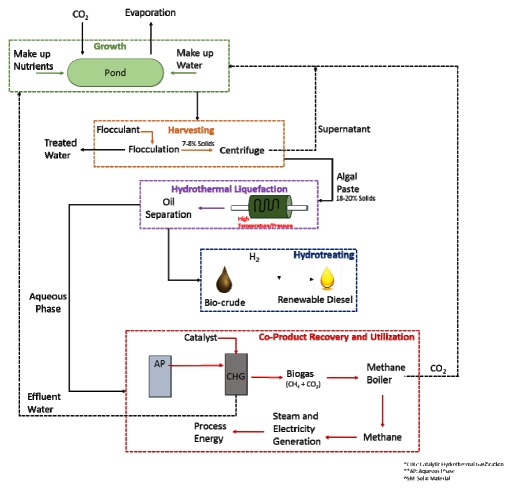
 DownLoad:
DownLoad: 